This section contains entries about our botanizing in Baja California written for the UC BEE (Oct 2012 to Aug 2021)
and The UC Hive (2022-), monthly newsletters for volunteers and staff of the UC Berkeley Botanical Garden.
Click on any photo for a larger image.
THE UC HIVE OCT 2023
November 2022
Over the season, we found ourselves making a number of trips to Loreto for various reasons. On our first trip in late November, only a few weeks after we’d settled in at home, we happened to stop at a familiar arroyo right by the highway as we were returning to Mulegé. I had only planned to take a quick look before we continued northward.
Once out of the car, I looked around and from what I could see through the glare of the midday sun off of the pale arroyo bottom, it didn’t seem like much was happening botanically, surprising considering the amount of rain that had fallen in mid-late September. As my eyes adjusted, I could see a few plants in the sandy bottom and started down the low bank to check them out.
You can jump from here to the sections on the Science Fair or San Javier Mission.
For a full list of this month's plants (with family, Latin name and common names in both English and Spanish), visit this page.
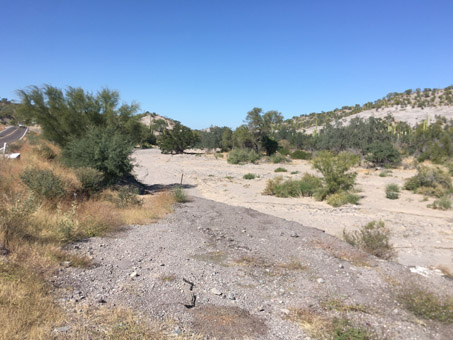
Arroyo near Km 16 N of Loreto. The highway used to be straight ahead then curve to the left. It was washed away and the new road is visible top L. The asphalt ends in a 1.5 m dropoff (center).
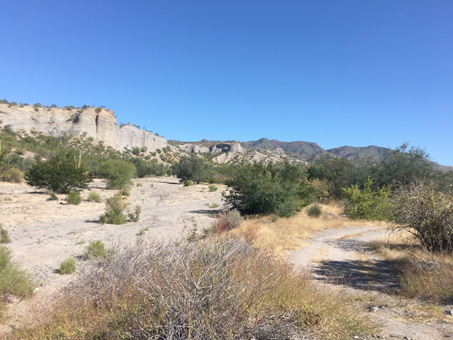
Looking southeast down the arroyo. Besides the green trees and shrubs, it appeared to be quite dry.
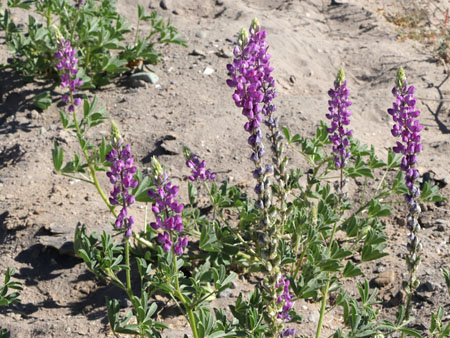
Then I saw the Arizona Lupines (Lupinus arizonicus, Fabaceae). They had been hiding behind and below a bush sitting on the bank.
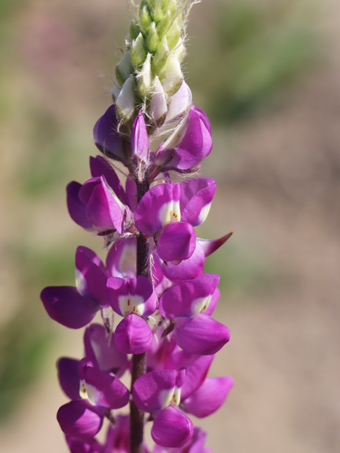
Arizona Lupine flowers vary from bluish-purple to fuchsia but the central white spot splashed with orange dots is fairly consistent.
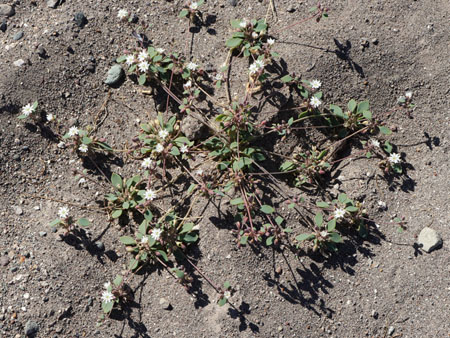
As I adjusted even more to the glare, I could see a number of small plants in the bottom of the arroyo, like this Desert Drymary / Ramitas Golondrina (Drymaria holosteoides var. holosteoides).
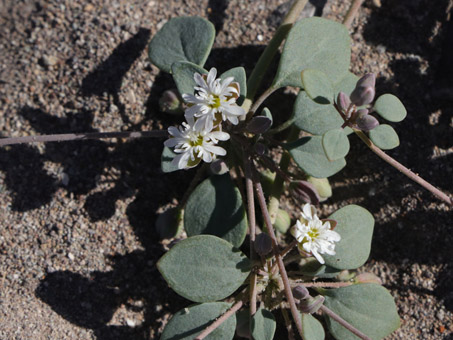
The leaves of Desert Drymary are somewhat succulent and the plant spreads by rooting at the nodes where the stems touch the ground. It's common on beaches and in sandy soils.
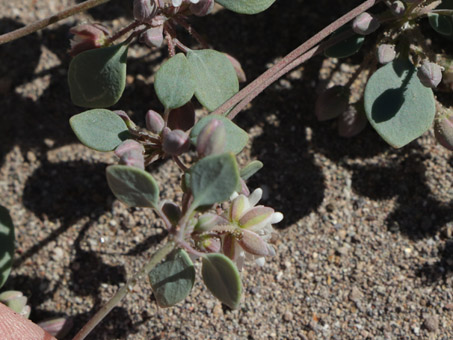
Desert Drymary stem, showing the whorled leaves & the inferior side of the flower. The 5 sepals are green with rosy midstripes. This variety is endemic, found from near San Felipe in BC to Bahía Magdalena in BCS.
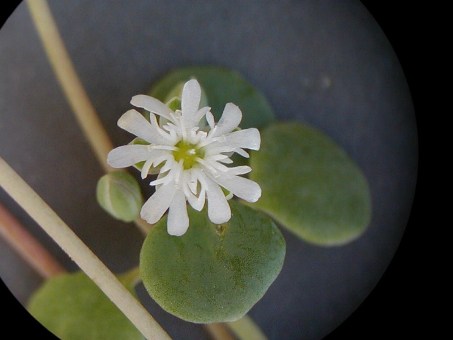
10X closeup of the 10-15 mm D white flowers of Desert Drymary, showing its five delicately dissected petals, each with two larger outer lobes & two sets of successively smaller lobes. The 5 stamens are white.
As I wandered, I saw lots of other small specimens of familiar species in the arroyo bed as well as a number of shrubs that were still getting their leaves on.
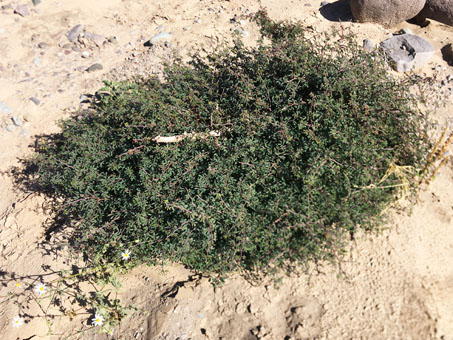
Fairyduster / Tabardillo (Calliandra californica) is a peninsular endemic, found throughout most of the desert regions. You can see Fairyduster at UCBG in the Baja California section.
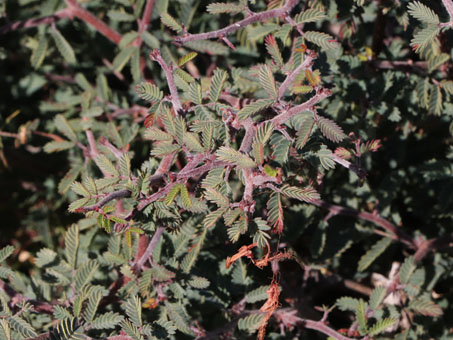
There are two species in this immediate vicinity. While easy to distinguish when in flower (C. californica has red flowers; C. eriophylla's are pink & white), that isn't always the case: C. californica has short, dense hairs on the young herbage while the other does not.
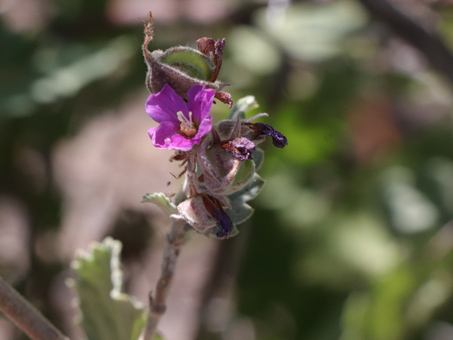
Teabush / Malvarosa (Melochia tomentosa var. tomentosa) is a native perennial herb or shrub that occurs occasionally in desert scrub in the southern 2/3rds of the peninsula. It can also be found across the Gulf on mainland Mexico, in the sw US and to C & S America.
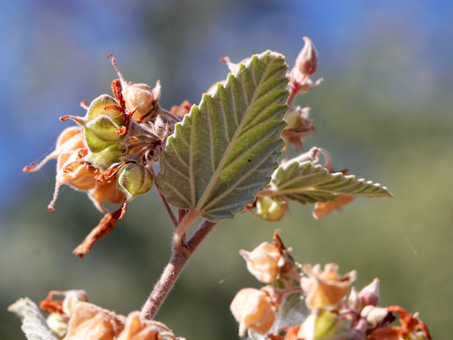
Teabush flowers are about 12-18 mm D. The leaves are thick and densely stellate-hairy with prominent veins. Fruits are 5-winged pyramidal capsules with a long beak. In disturbed soils, such as arroyos and roadsides, the plant can be quite common and abundant.

Canyon Snapdragon (Pseudorontium cyathiferum) were popping up all over the arroyo bottom. This was a large one, at all of 25 cm H.

I'm infatuated with Canyon Snapdragon.
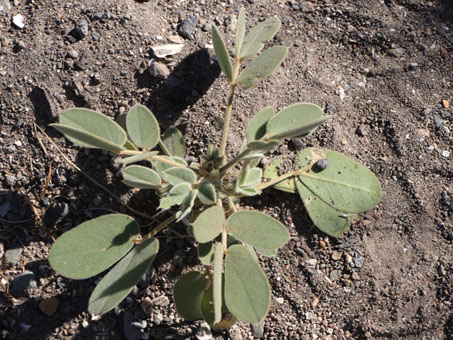
Gulf Cassia / Hojasén (Senna confinis). The leaves are velvety.
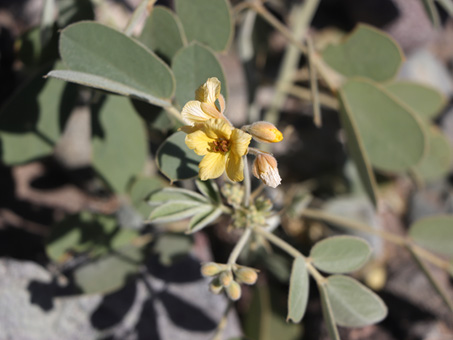
Gulf Cassia flowers are c. 15 mm D with 5 petals and stamens.

Blazing Star (Mentzelia adhaerens). It was a really good summer for this native annual species. Many friends complained about their dogs coats being covered in it after a walk in the desert. Here, it's covered with the hairy cypselae (fruit) of Sweetbush (Bebbia juncea).
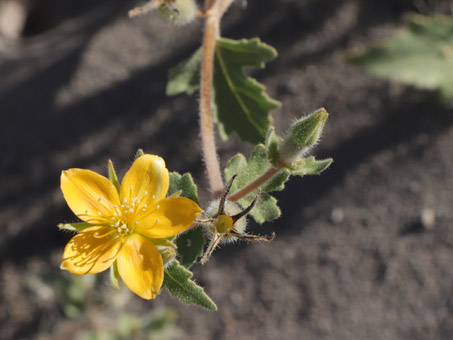
Blazing Star flower and fruit. Even though this is a pesky plant because it clings like velcro to everything, it is very attractive & a favorite of pollinators. Fl c. 2 cm D.
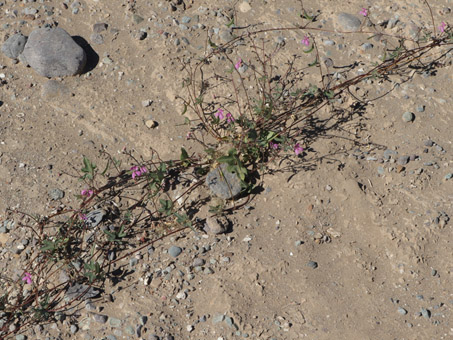
Slimjim Bean / Frijolillo vines (Phaseolus filiformis) were spreading out more than 2 meters across the arroyo bed. Leaves are trifoliate.
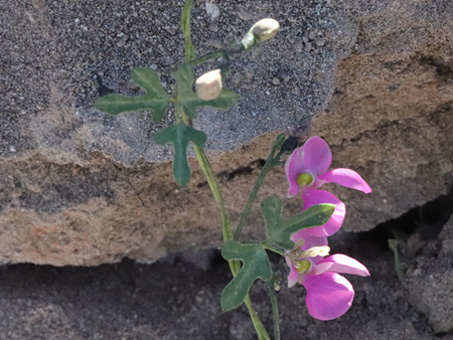
The dark pink flowers of Slimjim Bean are distinctive, in that the keel petal forms a lime-green corkscrew at the center of the flower.
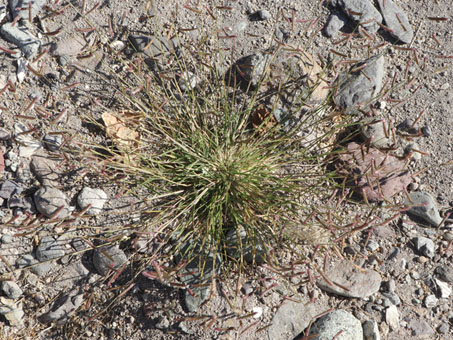
Six-weeks Grama / Navajita (Bouteloua barbata var. barbata), a common annual native grass esp. in BCS, is abundant after summer rains and may persist through to spring. Culms can reach c. 35 cm H.
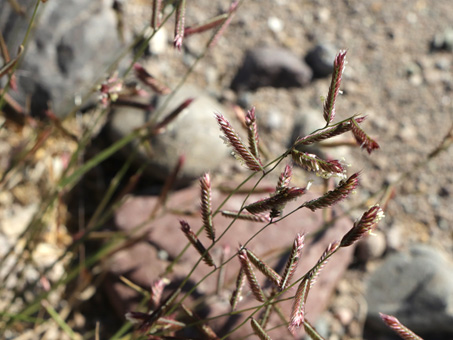
Six-weeks Grama. The spikelets are arranged on only one side of each 10-27 mm L branch, like the teeth of a comb. Annual grasses like these are important forbs for small wildlife species.
To this point, I had been slowly walking away from the car and was only about 50 meters NE down the arroyo, my eyes peeled on the ground, scanning for plants but also trying to block the bright sunlight with my visor. Checking my watch and feeling the sun beating down on me after only 20 minutes, I started to make my way back towards the car. I reached the trail I had taken down into the arroyo and as I stood there scanning the bank that was at almost shoulder level, I picked out a couple of species I´d missed on the way down.
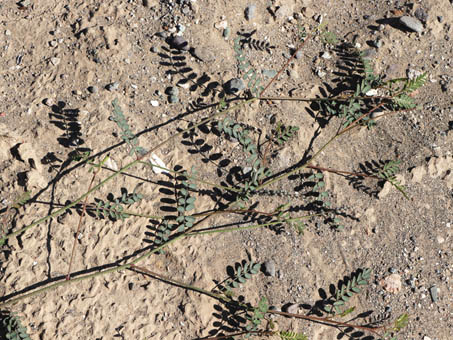
Peninsular Marina. (Marina peninsularis). This annual, prostrate glandular herb can form thick mats if given the chance. It occurs sporadically in much of BCS and just northward into BC.

The flowers of Peninsular Marina occur on short spikes. Each pea flower is c. 5 mm L and is purple (reddish to bluish). The leaflets of the pinnate leaves are only about 2-3 mm L.
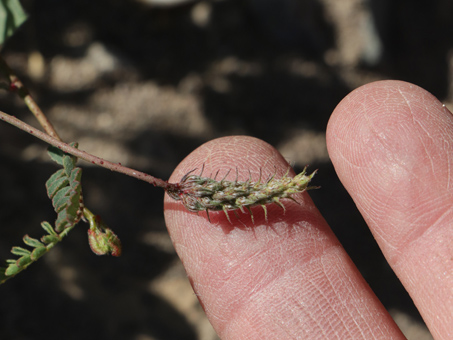
From what I can tell, not having had the opportunity to dissect this, the bristly-looking structures appear to be a reflexed lobe of the calyx that encloses each tiny pod of Peninsular Marina.

Fluffy seeds of Rock Hibiscus / Malva Blanca (Hibiscus denudatus) sit in the opened capsule, waiting for a puff of air to carry them off.
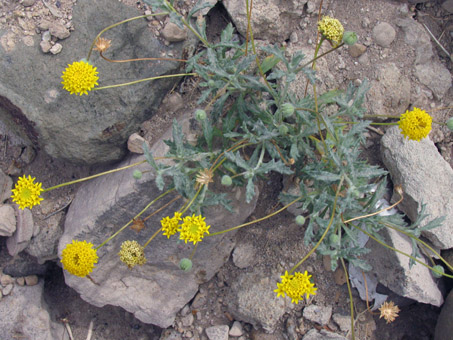
Desert Yellow-head (Trichoptilium incisum). This has been a very elusive species. It was only the 3rd time I´ve seen it in the 20+ yrs I´ve been botanizing. I've only seen this annual in the Fall after a wet summer. It is more common in the ne & nw part of BC (as well as sw US) but extends just into ne BCS.

Desert Yellow-head. The first plant I ever saw was about 6 cm H with 1 head and a rosette of pubescent, gray-green, coarsely toothed leaves. The heads are gen. discoid with 30-100+ flowers. The outer fls may be enlarged and ± bilabiate.
I was contentedly snapping photos and when I stepped into the shadow of a tree, I saw that not 5 meters in front of me was the edge of the dropoff from the old road bed and a pleasant surprise. The cut created an area of NE facing shade that was home to a number of happy plants.

This specimen of Baja California Star-Violet (Stenotis brevipes) was about 60 cm H x D. While it was in the shade, it does well in exposed arroyo beds and hillsides.

The 10-15 mm L salverform flowers of Baja California Star-Violet are 4-merous, the lobes each about 3-5 mm L. Flowesr may persist once withered, attached to the 2.5 mm D globose, partly inferior capsule.

Palmer Rock-Mustard (Dryopetalon palmeri) is a native annual. It's another species with interesting flowers, each about 1 cm D.

Palmer Rock-Mustard (Dryopetalon palmeri). It occurs mostly along the eastern coast of BCS, but is also present in w Sonora state.
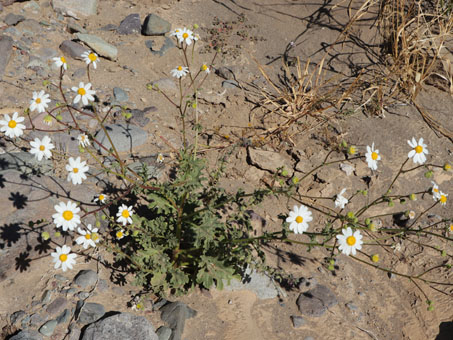
Coastal Rock Daisy / Manzanilla (Perityle crassifolia var. robusta). Yet another white Perityle, this an endemic variety.
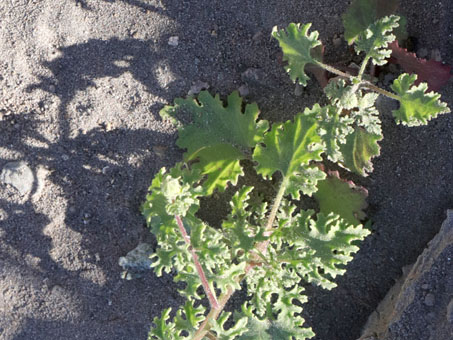
Coastal Rock Daisy has highly dissected, succulent leaves. Found from Mulegé to the Cape, where there is another localized endemic variety.
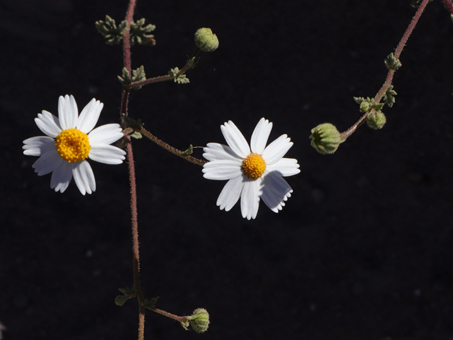
Coastal Rock-Daisy buds and flowers.
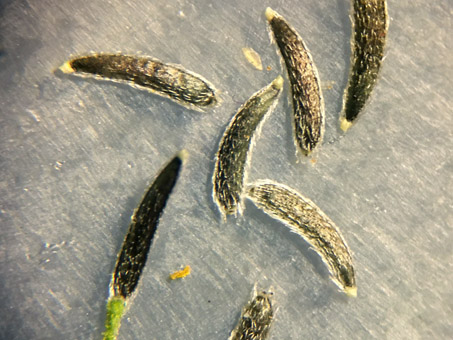
Cypselae of Coastal Rock Daisy are flattened, lack a pappus bristle and are 1-2 mm L

This year's ubiquitous yellow comp: Desert Chinchweed / Manzanilla del Monte (Pectis papposa var. papposa.
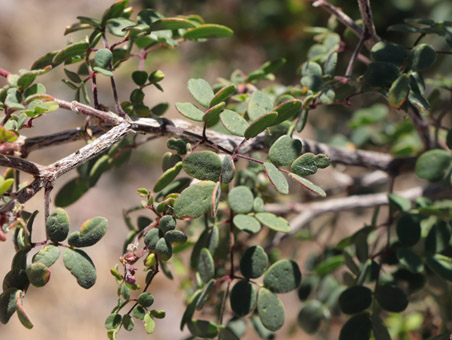
Peninsular Caesalpinia / Palo Estaca (Caesalpinia pannosa) is a small to medium endemic shrub with pinnate leaves.
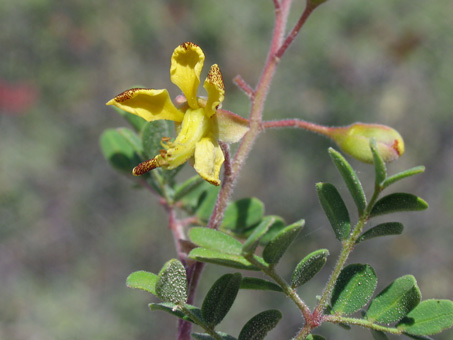
Flowers of Peninsular Caesalpinia are about 15 mm D with 5 petals, the backs of which have brownish-orange oil glands.

Peninsular Caesalpinia pods are c. 4-6 cm L, thin, flat and covered with minute, sessile oil glands.
January 2023 — Scientific Street Fair / El Tianguis Científico
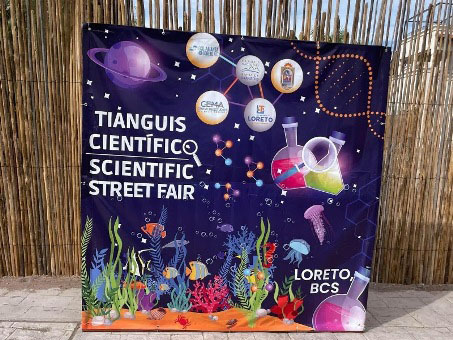
Eco-Alianza, a environmental NGO in Loreto hosted a science fair in January and I was invited to participate.
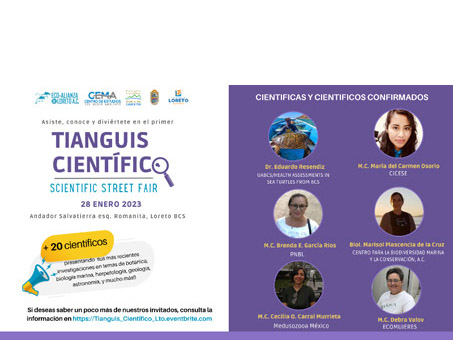
Mine was the only botany booth among the twenty or so focused mainly on the marine environment. I had the opportunity to talk with visitors about my Mulegé Flora research paper.

Getting ready for the fair: Repurposing heavy botany books to press sample specimen vouchers for display and the dissecting microscope.

The Fair was set up on a popular tourist walkway near the harbor waterfront.
EcoAlianza did a great job with the booths, from providing the signs to tables to lighting. I even had a loaner microscope and I prepared some samples for viewing. I chose plants with interesting features to wow visitors. I still have vivid memories of seeing glandular hairs & Euphorbia flowers for the first time in the microscope years ago when I started studying plants, so I was thrilled to see other's reactions to Pegarropa (Mentzelia adhaerens) and Bur Bristlegrass (Setaria adhaerens) with their velcro-like hairs, as well as the diminutive but beautiful flowers of Canyon Snapdragon, the noxious and invasive Salt Cedar (Tamarix ramosissima), and Fringed Sandmat (Euphorbia setiloba).

Not only kids were interested
in looking in the microscope.
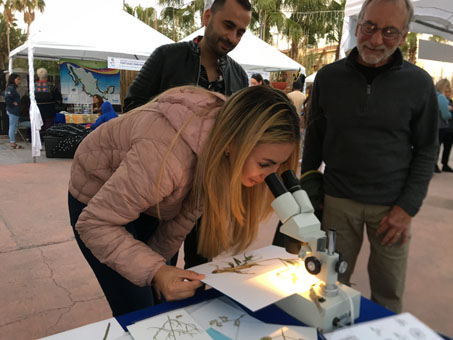
Quite a few adults were fascinated by hairs, glands, & minute flowers.

















































